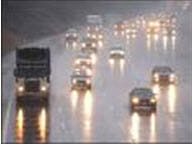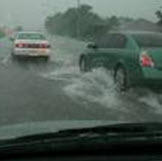Helpful Tips For Driving In Rainy Weather
Slow down — The first few minutes of rainfall are dangerous. After the first drops of rain seep into the road, oil from the asphalt, road tar, oil droplets and grime float to the road surface. A thin film of oil between the surface and your tires cause roads to be slippery, making you lose control when you brake or steer hard. Slow down and wait until the rains wash away this film. Roads are slipperier after a light drizzle than after a heavy rain, but this does not mean it is safe to drive at high speeds as uneven patches on the  road create water ponds where hard braking or sudden steering can make you lose control. Remember, rainwater changes road conditions and affects the reliability of your braking system. Be careful. Slow down.Avoid flooded areas — A few minutes of torrential rainfall can cause flash floods. The key to survival during flooding is to avoid running water, such as swollen streams and low water crossings.
road create water ponds where hard braking or sudden steering can make you lose control. Remember, rainwater changes road conditions and affects the reliability of your braking system. Be careful. Slow down.Avoid flooded areas — A few minutes of torrential rainfall can cause flash floods. The key to survival during flooding is to avoid running water, such as swollen streams and low water crossings.
Know your way — Whether going on a long trip or coming home from the office, it’s better to know well the natural features of your route. Is the road on low or high ground? Can it get flooded? Is there a canal nearby that floods easily?Watch out for road hazards — A heavy downpour can hide street diggings, potholes, ravines, road hazards and debris. Be vigilant when following tall vehicles like an SUV, van or truck with high ground clearance and large tires.Better safe (and late) than sorry — When it starts raining heavily and you think driving can be a problem, just stop, whether you are familiar with the route or not and regardless of road visibility. Better wait until the rains die down or visibility improves.Dry your brakes — As your wheels go through wet roads, splashing water can wet your brakes, where a thin film of water can accumulate and reduce brake performance. Look at your rearview mirror and if the car behind you is at a safe distance, step very lightly on the brake pedal once or twice.

Use your wipers — Your wipers are there to keep your windshield clean and help your vision. Keep your windshield clean and check your wipers before you drive out in the rain. Make sure your windshield washer system is working.
Switch on your headlights — Use your headlights in driving rain to make your car more visible to oncoming traffic, decreasing the chances of getting into a head-on collision.
Use hazard lights only when needed — Many drivers use hazard lights wrongly, switching them on to show other drivers that road conditions are hazardous. Only use hazard lights to warn other drivers that your vehicle is or is about to become a road hazard.
Watch out for pedestrians — Be careful when driving in populated areas. They may suddenly try to cross or move to the road to avoid water puddles or muddy ground.
